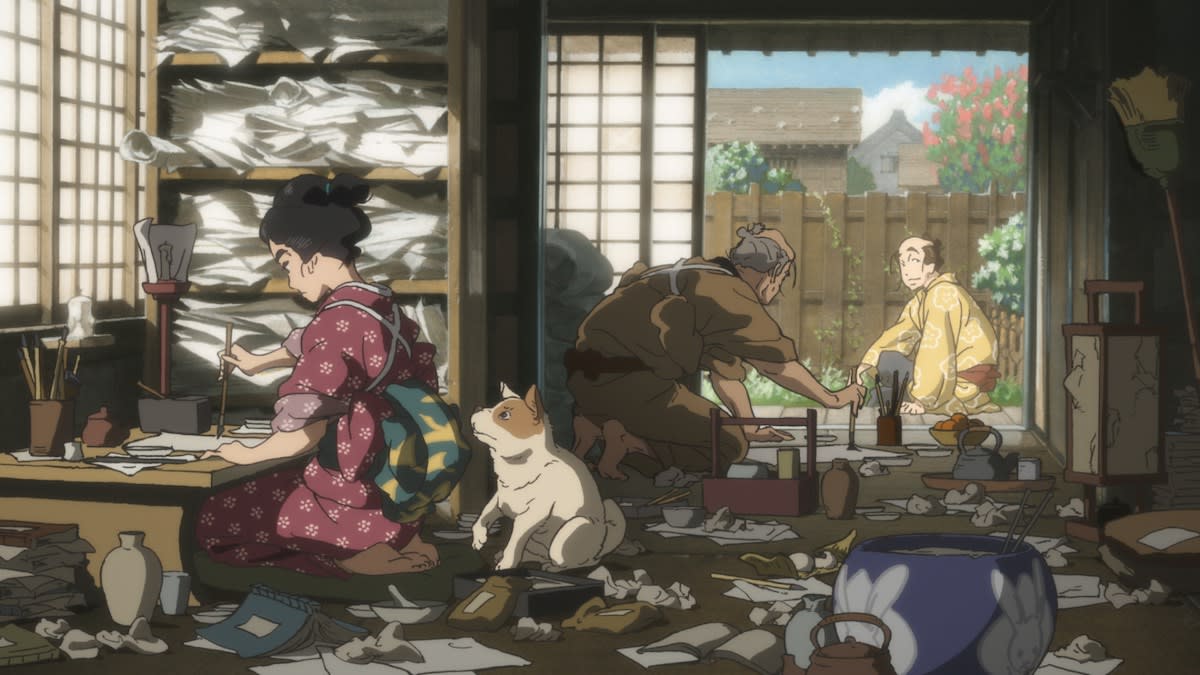Film Review: ‘Miss Hokusai’

The annals of Western art are woefully sparse when it comes to female painters, which is just one of perhaps a dozen reasons that “Miss Hokusai” comes as such a refreshing anomaly among anime exports. Adapted from a woman-made manga (“Sarusuberi”) by a female screenwriter, this intriguingly atypical toon eschews such common ingredients as fantastical creatures (though there are a few supernatural twists) and schoolboy sexism in favor of attempting to capture the inner dynamics of an early-19th-century artistic family, focusing on ukiyo-e master Katsushika Hokusai’s relatively obscure daughter, O-Ei, a fellow painter about whom just enough is known that the film is free to invent the rest. The fest-friendly subject could be a tricky sell to international auds, but shines as an example of one creative soul paying tribute to another.
Though hardly a household name, the elder Hokusai (referred to as Tetsuzo by his inner circle) was responsible for creating what is arguably the most widely reproduced piece of Japanese art,“The Great Wave Off the Coast of Kanagawa” (an iconic azure swell that gets a visual wink midway through the film). Written and rendered with an eye toward realism, the film simultaneously takes advantage of the cartoon format to honor a figure who, in light of the line-drawn style he popularized, served as one of the godfathers of Japanese anime.
Hokusai produced tens of thousands of artworks in his day, including a series entitled “Thirty-Six Views of Mount Fuji” that was sold far and wide as woodblock prints. Meanwhile, his more character-centric illustrations paved the way for some of the animation techniques reflected in the film’s own style. Embracing that connection, “Miss Hokusai” imagines that some of the master’s best-loved paintings may have actually been the work of his equally talented daughter, a still-young lady of 23 years (Anne Higashide) whose talent and personality spilled outside the lines of polite Japanese society.
From the outset, director Keiichi Hara (“Colorful”) makes it impossible to ignore this mix of modern independence and rigid tradition, offsetting its demure, arm’s-length view of the kimonoed O-Ei making her way across Edo (as the future Tokyo was known in 1814) with explosive electric guitar music on the soundtrack. In public, O-Ei knows and respects “her place,” but at home in Tetsuzo’s studio, she’s as brash and uninhibited as her father (Yutaka Matsushige), smoking a pipe while sketching erotic drawings that would make contemporary Japanese ladies blush.
Tetsuzo withholds affection but encourages his daughter’s gifts, allowing O-Ei to step in and finish an important dragon painting just before the commission is due — a process that dramatically requires her to tame the creature from the night sky. Scenes like these supply excitement in what otherwise proves to be a rather subdued narrative, one that relies so much on subtext and nuance that it may bore or frustrate those accustomed to more dynamic (or at least melodramatic) toons. At times, “Miss Hokusai” manages to be that rare toon whose attention to character psychology and real-world detail can actually rival live-action, especially in moments where the father-daughter dynamic is concerned. (O-Ei is not Tetsuzo’s only child, and the film includes a heartbreaking tangent in which the workaholic dad all but ignores O-Ei’s blind younger sister, O-Nao.)
Overall, the film lacks a traditional linear plot, amounting instead to a series of episodes in O-Ei’s life — a format consistent with Hinako Sugiura’s “Sarusuberi” series, but not necessarily the most riveting experience to watch in one sitting. United by O-Ei’s presence, these vignettes have been woven together in such a way that the narrative flows, even though it lacks suspense or any sort of obvious goal.
In one of the film’s more unusual scenes, O-Ei accompanies her father to visit a possessed courtesan, necessitating an impromptu artistic exorcism of sorts: like a doctor making a house call, Tetsuzo calms the woman’s restless spirit by making a last-minute adjustment to a hellish canvas that hangs in her chamber. In another, the sexually inexperienced young artist (believed to be the best painter of women around) spends an intimate night with a geisha, providing a surprising cure for her naivete while complicating her feelings toward Hatsugoro (Michitaka Tsutsui), the most respectful of her father’s other pupils, who serve primarily as comic relief.
Making a genuine effort to capture Edo-era Japan without necessarily playing slave to history, “Miss Hokusai” is liberated from the crushing production design costs of an equivalent live-action film. Audiences see the city as it must have looked at the time, the hand-drawn characters smoothly interwoven with stylized CG sets (less vivid than the painted views featured in anime of a decade or so earlier). Compared to the high bar set by anime powerhouse Studio Ghibli, Production I.G’s work has always left something to be desired, and a close study of the film’s technique reveals how little actually moves in any given frame (a face turns slightly or a dog does something adorable, while everything else appears frozen). Still, animation proves the ideal medium for “Miss Hokusai’s” relatively tame story, allowing audiences to admire the family’s artwork within a world that they were partially responsible for creating.
Related stories
Annecy: Chile's Nino Viejo, Pinata, Punkrobot Set 'Legend' (EXCLUSIVE)
Annecy: Estudio Teremim Unveils TV Series 'Lulina' (EXCLUSIVE)
Annecy: Sergio Pablos Preps Directorial Debut 'Klaus'
Get more from Variety and Variety411: Follow us on Twitter, Facebook, Newsletter
